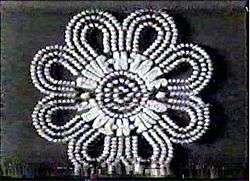Give-n-Take
Give-n-Take is an American television game show which ran on CBS from September 8 to November 28, 1975. Jim Lange hosted, with Johnny Jacobs announcing. The series, which replaced Spin-Off (also hosted by Lange and announced by Jacobs), ended after 60 episodes.[1]
| Give-n-Take | |
|---|---|
 Give-n-Take logo. | |
| Directed by | Bill Carruthers |
| Presented by | Jim Lange |
| Narrated by | Johnny Jacobs |
| Theme music composer | Stan Worth |
| Country of origin | United States |
| No. of episodes | 60 |
| Production | |
| Production location(s) | CBS Television City Hollywood, California |
| Running time | approx. 26 Minutes |
| Production company(s) | The Carruthers Company Warner Bros. Television |
| Release | |
| Original network | CBS |
| Original release | September 8 – November 28, 1975 |
Gameplay
Four female contestants competed to accumulate prizes with a total value as close to $5,000 as possible without going over.[2] The returning champion and three challengers each sat in one portion of an eight-spaced board, shaped like a daisy, with a neutral "advantage space" separating each contestant from the next. Values of individual prizes were not revealed at any time during the game.
A prize was described to the contestants, and Lange asked a toss-up question. The contestant who buzzed in and gave the correct answer took control of all four advantage spaces for that turn in addition to her own, giving her a total of five spaces. Each of the other three contestants controlled only the space in which she sat. The contestant in control pressed her buzzer to stop a large spinning arrow at the center of the board. The contestant on whose space the arrow stopped won control of the prize and could choose to either add it to her bank, or pass it and/or one or more already-banked prizes to an opponent.
After a prize was assigned, a bell or buzzer sounded to indicate whether or not that contestant's bank value was over $5,000. The actual value of the bank was never revealed; only whether or not it was below the $5,000 target. Play then repeated in the same manner, with a new prize described.
A contestant could freeze after any turn if she thought she was close to $5,000, and any contestant whose bank exceeded this total was automatically frozen. A frozen contestant was still eligible to answer toss-ups. However, if the arrow stopped on her during a spin, the prize at stake for that turn was carried over to the bonus round and she had to pass one or more of her own prizes in order to reduce her bank.
After seven spins, the bank totals were announced and the contestant closest to $5,000 without going over won the game and the championship, kept her banked prizes, and advanced to the bonus round. If three of the four contestants became frozen, the fourth automatically won the game. Defeated contestants received parting gifts.
Bonus round
The champion selected one of the eight spaces on the board and had one chance to stop the arrow on it. Doing so awarded all prizes described in that day's main game, in addition to everything she had already won.
Champions stayed on the show for a maximum of five days, or until they reached the $25,000 winnings limit that was in effect for CBS game shows at the time.
Broadcast history
Give-n-Take debuted on September 8, 1975, at 10:00 am Eastern (9:00 am Central/Mountain/Pacific), replacing the Nicholson-Muir series Spin-Off and facing NBC's popular Celebrity Sweepstakes (ABC did not program at 10:00 and had returned the 10:30 slot to its affiliates in 1969).
The series moved to 4:00 pm (3:00 Central) on November 3, replacing Musical Chairs, where it struggled in the ratings for its last four weeks against the ailing soap Somerset on NBC and the short-lived revival of You Don't Say! on ABC. Give-n-Take was replaced by Tattletales on December 1 in a scheduling shuffle.
See also
- Say When!! (1961-1965 game show similar to Give-n-Take)
References
- Hyatt, Wesley (1997). The Encyclopedia of Daytime Television. Watson-Guptill Publications. p. 186. ISBN 978-0823083152. Retrieved 22 March 2020.
- Schwartz, David; Ryan, Steve; Wostbrock, Fred (1999). The Encyclopedia of TV Game Shows (3 ed.). Facts on File, Inc. p. 85. ISBN 0-8160-3846-5.